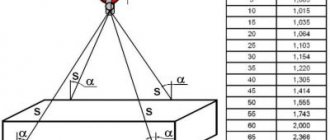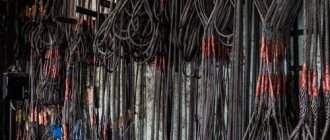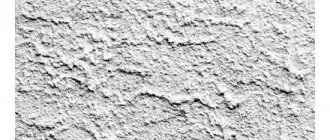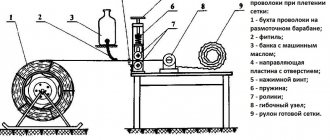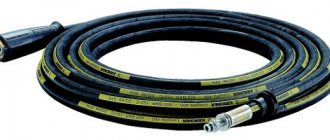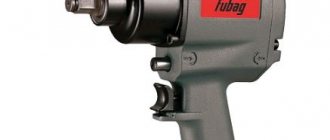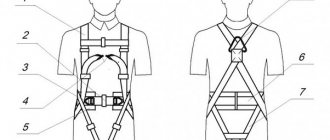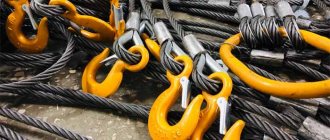For the safety of lifting and loading and unloading operations, slings, connecting elements, grips, blocks and other devices must undergo regular inspection. The rules and procedures for conducting inspections are developed either by a specialized organization or by qualified engineering and technical personnel in accordance with state recommendations on labor protection. To do this, first of all, an inspection log is compiled, where the results for each individual device are recorded. Based on the results of the inspection, a decision is made on whether the device can be accepted for further work or not.
Rope sling inspection rules
During an external, visual inspection of the sling, the following is determined:
- compliance with the technical passport data for the equipment (designation, name);
- general state;
- quality of loops, rope branches, connecting elements, grips;
- quality of sealing of the free end of the sling.
Inspection of defects and breaks is carried out visually and using a magnifying glass with tenfold magnification (if necessary).
Instrumental inspection of rope slings involves measurements of identified defects:
- thinning of the rope in diameter;
- degree of corrosive wear, abrasion, breaks, bending;
- level of sling waviness;
- the length of the sling branches, the difference between the declared lengths in the factory specifications and the actual length.
Measurements are carried out using a ruler, tape measure, micrometer and caliper.
An internal inspection of rope slings is needed to determine the technical condition and integrity of the internal strands and core. Such an inspection is carried out selectively, mainly for slings that, during instrumental inspection, showed the greatest number of defective damages (presence of corrosion, abrasion of individual wires).
For internal inspection of the problem area of the sling, on one side it is rigidly fixed with a clamp. Using the second clamp, the sling is rotated against the direction of lay so that the wire strands free the core for inspection.
By opening the lay of the sling, you can identify breaks, damage and deformations, the condition of the core, a decrease in diameter, and the degree of wear of individual strands.
Important. After inspection, it is recommended to lubricate this section of the rope sling inside and out.
Rejection of textile slings
The norms and rules for rejecting textile slings prescribe that they should not be allowed to work in the following cases:
- When a product is missing a label or the information on it is impossible to read.
- If there are knots, cuts, or other damage on the tape, amounting to more than 10% of the total length, or a single cut larger than 50 mm is detected.
- The presence of textile delaminations (except for the edges) totaling more than half a meter.
- When textile slings are contaminated by more than 50% with petroleum products, resin, paints, and dirt.
- If defects in the coupling mechanisms are detected.
Rejection of textile slings is also carried out if they do not withstand testing under a static load for 3 minutes, which must exceed the standard load capacity by 30%.
How to store it correctly
It is necessary to provide a place for storing load-handling devices, protected from the negative influence of external factors - exposure to hot metal, contamination with chemicals, mechanical damage. Slings should be stored hanging or on special racks. This is especially true for rope products. Leaving the slings on the ground in a twisted state may cause them to fail prematurely.
It is not recommended to place cargo slings near heat sources (blast furnaces, heating equipment). Synthetic products may melt. The lubricant contained in the rope core will protrude outward and be consumed faster during the operation of the pulleys. This can cause dry friction of the wires and the appearance of rust, which can lead to rapid wear and tear of the products.
Norms for rejecting slings
Textile slings
To assess serviceability, textile slings must undergo a visual inspection for compliance of the markings with the passport, serviceability of seams and loops, connecting elements and grips. They must also undergo an instrumental inspection to determine dimensions and defects. If the following deficiencies are identified, textile slings should not be allowed to work.
The processes occurring in the structure of the tape of textile slings upon contact with the above listed substances are not always visually noticeable, but can lead to irreversible changes in the material from which the slings are made. If contact of the slings with chemically active substances does occur, do not be lazy to once again inspect the slings for obvious defects.
When slings are used in conditions of elevated temperatures, the sling tape, mainly made of polyester or polyamide and serving as the material for textile slings, loses its strength and becomes brittle, and when the permissible temperature conditions are significantly exceeded, it can melt and even ignite. As you can understand, in this condition the slings are not suitable for further use.
This defect most often occurs either when there is a gross mismatch between the working load capacity of the slings and the weight of the load being lifted, or when lifting loads with a clearly uneven surface using textile slings. One way or another, if you find this defect on your slings during an osomer examination, they must be taken out of service.
The cause of this defect is similar in nature to the defect specified in the previous paragraph. Textile slings serve for a long time and correctly only if the entire working part of the slings is in proper condition. And the presence of even such seemingly insignificant damage is the first sign that the condition of your slings needs to be addressed.
Another frequently occurring defect is caused by the use of textile slings when lifting loads with sharp edges, without the use of protective pads or special covers. Even a small cut or cut in the sling tape can lead to the sling breaking at the most inopportune moment. Do not let this happen, use protective devices, and if such a defect occurs, immediately remove the slings from use.
No matter how far you can drive a car with punctured tires, you can’t work with textile slings that have this defect. The presence of through holes in the sling tape when exposed to loads can lead to an increase in the area of the holes and, as a result, breakage of the slings.
The tape of a textile sling is essentially an interwoven fabric, stitched in a certain way in several layers. This defect occurs either due to a natural decrease in the density of the belt threads, as a result of alternating application and removal of loads, or due to local mechanical damage to the belt from repeated contact with the uneven surface of the transported loads. The essence of the problem lies in the decrease in the homogeneity of the belt structure and the accompanying critical reduction in the permissible working load. It is precisely because of these changes in the structure of the belt that sling manufacturers are forced to refuse customers the repair of textile slings. And to tell the truth, textile slings cannot be repaired at all.
Yes, textile slings have almost the same degree of compactness and ease of use as chain slings. You can also put them in a box or roll them up in a pile and put them somewhere until you need them again, unless of course you use them 24/7. But this method of storage can lead to the slings becoming tangled and even tied in a knot. The situation is almost the same as with headphones for a smartphone in your pocket. The problem is that when it comes to using slings quite often there simply isn't time to properly untangle them. Operating slings in this form leads to uneven distribution of load inside the sling tape and, ultimately, failure of the textile sling.
Also, a separate case should be highlighted when a knot on a textile sling was formed not as a result of the tape being tangled, but as an attempt to save money by tying together two pieces of a sling that had previously failed as a result of non-compliance with these discard rules. The use of such slings is STRICTLY PROHIBITED.
Source: podyom-texnika-sar.ru
What you need to know and consider when inspecting chain slings
When inspecting chain slings, it is necessary to check the presence and compliance of markings, the integrity and condition of the end links of the chain, and connecting equipment. The sling is also inspected along its entire length to identify obvious defects, chips, stretching and deformation of the links.
Instrumental measurements during inspection allow us to determine:
- condition of the sling chain links (diameter, presence of stretch, length);
- wear percentage;
- the presence of critical deformations, chips;
- correspondence of the length of the sling and each branch, the difference in the lengths of the branches.
It is important that the safety factor of chain slings corresponds to that stated in the technical specifications for a given range of rigging equipment.
General inspection of lifting devices
When inspecting equipment for grasping loads (hooks, blocks, connecting devices), it is necessary to determine visually and using measuring equipment the presence of the following defects:
- compliance with the declared performance characteristics;
- state;
- cracks, chips, wear;
- performance.
Rejection of load-handling equipment is carried out in case of cracks, breaks, working wear of 10 percent, deformations (bending, change in fastening angle, defects in connections).
Based on the results of all stages of inspection of each sling (rope), a log of scheduled inspection of lifting equipment is filled out. Rejection is carried out (slings are not allowed for further use) or the equipment is allowed to be allowed to carry out lifting operations.
Routine inspection of slings, with recording of inspection data in a log, is a necessary safety requirement.
| № | Designation | Name | Quantity | Material | Weight 1 pc. | The mass of everyone | Notes | Signature |
| 1 | GOST 7667-80 | Steel rope 23.5 | 1 | 87 | 87 | No |
